Cables and its types
Welcome to “Cables and its types.” After reading this article, you will be able to: List the common cable types and their characteristics. Understand the purpose of each cable. Identify the most appropriate cable type in varied scenarios.
Also visit: Wired Connections
Cables and its types
Here are the common cable types:
- Hard drive cables like SATA, IDE, and SCSI connect a central processing unit, or CPU, to a device’s main or default storage.
- Network cables like coaxial, fiber optic, and ethernet connect devices and transmit data.
- Serial Cables like you might find on a keyboard or mouse are used for transferring power or data slowly over a distance.
- Video cables like VGA, HDMI, Mini-HDMI, DisplayPort, and DVI transmit video signals from a device to a monitor.
- Multipurpose Cables like USB, Lightning, and Thunderbolt are used for fast data transfers, fast power transfers, and connecting devices.
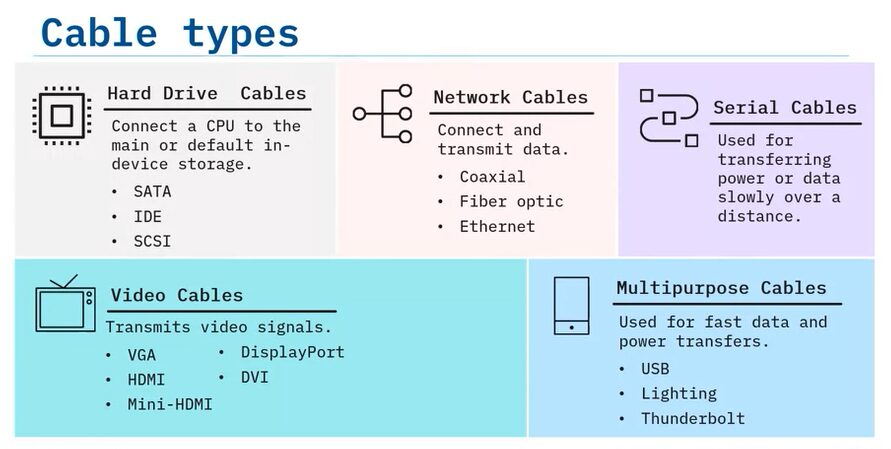
Hard drive cables
Hard drive cables connect a hard drive to a motherboard or controller card. The same cables may also be used to connect optical drives and older floppy drives. Hard drive cables include: SATA, IDE, and SCSI.
1) SATA stands for ( Serial Advanced Technology Attachment )
- SATA is the next generation hard drive cable.
- SATA carries high-speed data and connects to storage devices (hard disk, optical and solid-state drives).
2) IDE stands for ( Integrated Drive Electronics)
- IDE, is an older interface.
- The IDE cable is a 40-wire ribbon cable that is connected from the motherboard on one end to one or two drives on the other end.
3) SCSI stands for ( Small Computer System Interface )
- SCSI, was designed to support a wide variety of device types,
- This means there are different types of SCSI cables. They may be ribbon cables or standard round cables of 50, 68, or 80 wires. Up to 16 devices, including the motherboard or SCSI controller card, may be connected to one SCSI cable or daisy-chained together.
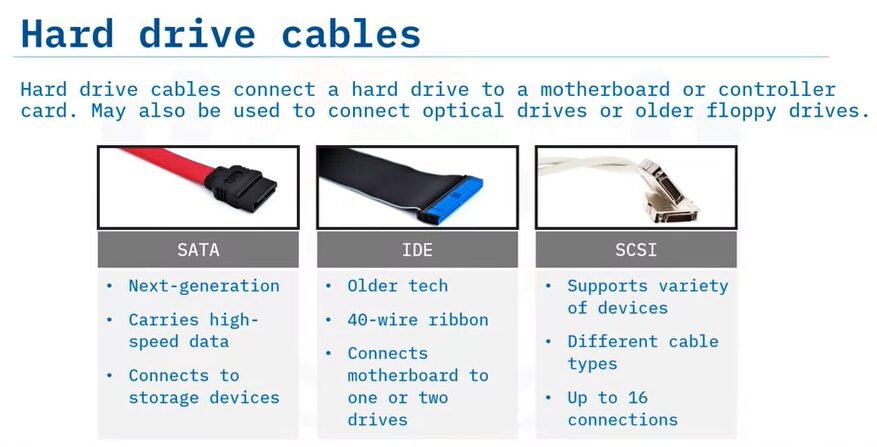
Multipurpose cables
Multipurpose cables connect devices and peripherals directly together without a network connection. They can transfer both data and power.
Multipurpose cables include: USB, lightning, and thunderbolt.
USB cables connect to a wide variety of peripheral devices. USB supports two speeds. Low speed supports data transfer rate of 1.5 Mbps at lengths up to 3 meters. Full speed supports data transfer rates of 12 Mbps at lengths up to 5 meters. USB cables can carry data and power.
Lightning cables are proprietary to Apple. They are used to connect Apple devices to USB ports. It can carry both data and power to charge the device.
Thunderbolt is another Apple proprietary cable. It comes as either copper or optical cable. The maximum length is 3 meters for copper and 60 meters for optical. It provides both data and power to peripheral devices, most commonly storage and display devices.
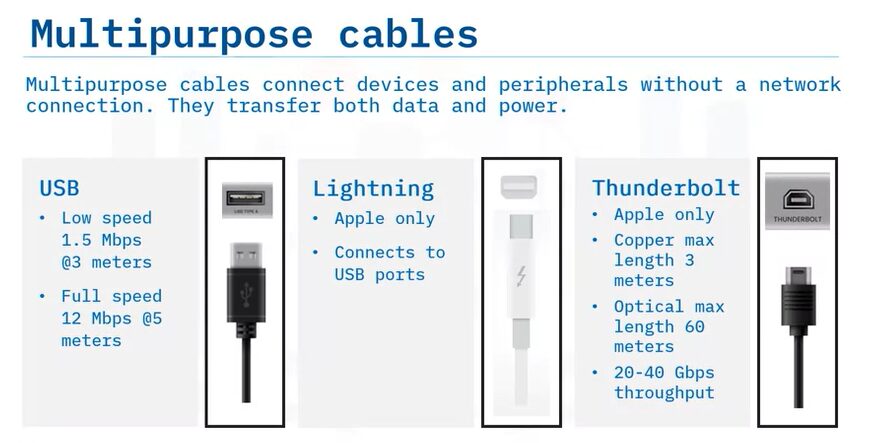
Video cables
Video cables connect a specific type of video port on a computer to a display. Each has its own connector type.
- VGA cables connect older analog video graphics adapters to a display.
- HDMI cables connect a high-definition multimedia interface to a display.
There are different types of HDMI cables. Type A is most common but is usually just referred to as HDMI cable with no type designation. Mini-HDMI is a HDMI type C cable. DisplayPort cables connect a DisplayPort interface to a display.
- DVI cables connect a digital visual interface to a display.
- DVI-D (-D for digital) supports only digital signals.
- DVI-I (-I for integrated) supports digital and analog signals. There are single-link and dual-link DVI cables.
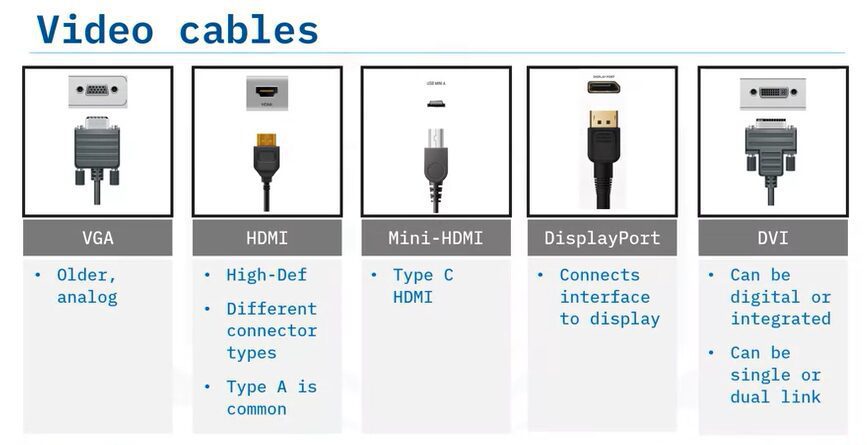
Serial Cables
A serial cable is used to transfer information between two devices using the RS-232 standard, which states that data bits must flow in a line, one after another, over the cable. Serial cables are used in modems, keyboards, mice and other peripheral devices which is why serial cables are sometimes called “peripheral cables”. However, video and multipurpose cables are also called “peripheral cables” for the same reason even though they might not use the RS-232 standard. In wired networks, network cables connect devices and route information from one network device to another. A network’s topology, protocol, and size determine what type of cable is needed. Some networks use only one type of cable, while others use a variety of cable types.
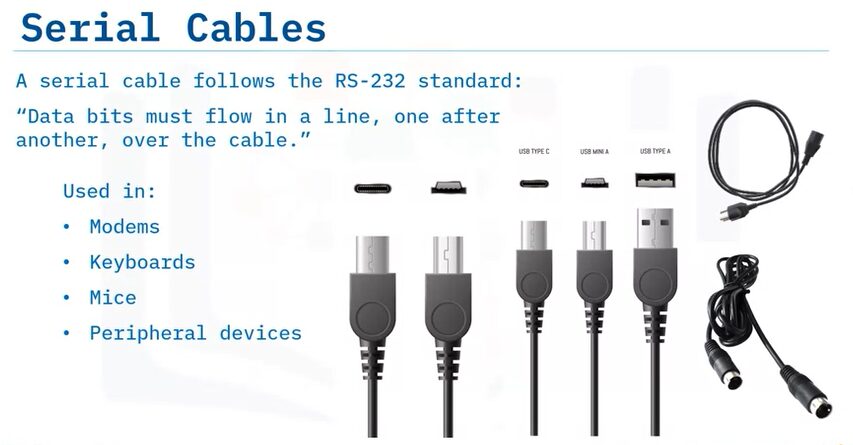
Here we will cover three types of network cables – coaxial, fiber optic, and ethernet cables.
The coaxial (or co-ax) cable was originally developed to connect TVs to home antennas. These days it is used to send cable TV signals to cable boxes, and internet to home modems. Coaxial cables contain an inner copper wire that is surrounded by insulation and other shielding. They are highly resistant to signal interference and can support greater cable lengths between network devices than twisted-pair Ethernet cables. The co-ax cable has a 10 Mbps capacity. The Data Over Cable Service Interface Specification, or DOCSIS, is a networking standard used in systems that provide internet across Cable TV lines. Coaxial cables use the DOCSIS standard.
 |
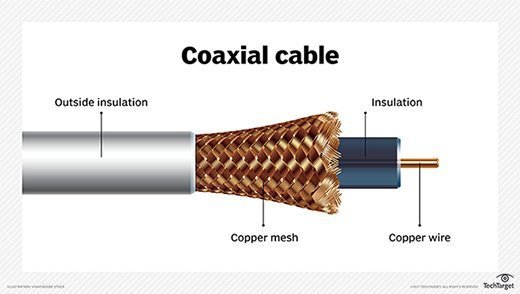 |
Fiber optic cables
Fiber optic cables are used in wide area networks, or WANs, because they work over long distances without much interference and can handle a heavy volume of data traffic.
Different types of fiber optic cables are used depending on the cost and the amount of bandwidth the cable can support.
There are two basic types of fiber cables:
- Single-mode carries only one light path, typically sourced by a laser. It has a much longer transmission distance.
- Multi-mode carries multiple light paths and is sourced by a LED and can carry multiple signals in the same line simultaneously.
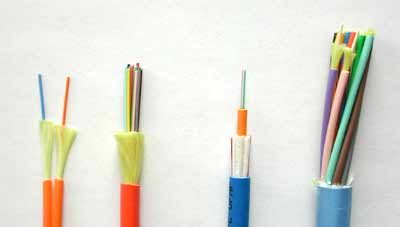
Ethernet or ‘twisted-pair’
Ethernet or ‘twisted-pair’ cables consist of four pairs of twisted wires to reduce interference. These cables ‘hardwire’ a computer to a LAN. Hardwiring is faster and more consistent than wifi.
They are available in two types – shielded wires or unshielded wires. Unshielded Twisted Pair, or UTP, cables are cheaper and more common. Shielded Twisted Pair, or STP, cables are more expensive and designed to reduce any outside interference that might interrupt data transmission.
Ethernet cables also have category numbers. A higher category number means the cable is newer and usually faster with better bandwidth. Category, distance, and bandwidth are factors that are considered when building networks using ethernet. There are many types and categories of ethernet cables, while all of them use the same connector on both ends, mixing up types can damage cables or hardware.
 |
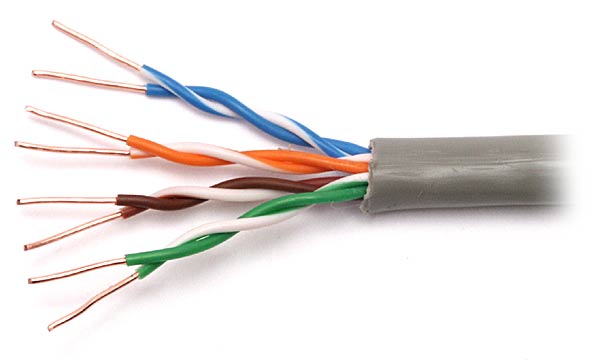 |
Summary
In this article, you learned: There are a many cable types, and each has a specific purpose. SATA cables have the latest hard drive cable technology. Multipurpose cables can be propriety or universal. Video cables come in a wide variety. Serial cables are used for peripheral devices. And Network cables include coaxial, fiber optic, and ethernet.

